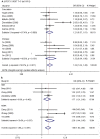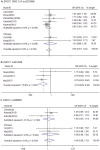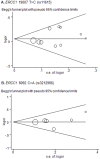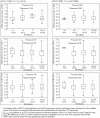Association studies of ERCC1 polymorphisms with lung cancer susceptibility: a systematic review and meta-analysis
- PMID: 24841208
- PMCID: PMC4026486
- DOI: 10.1371/journal.pone.0097616
Association studies of ERCC1 polymorphisms with lung cancer susceptibility: a systematic review and meta-analysis
Abstract
Background: Excision repair cross-complimentary group 1 (ERCC1) is an essential component of the nucleotide excision repair system that is responsible for repairing damaged DNA. Functional genetic variations in the ERCC1 gene may alter DNA repair capacity and modulate cancer risk. The putative roles of ERCC1 gene polymorphisms in lung cancer susceptibility have been widely investigated. However, the results remain controversial.
Objectives: An updated meta-analysis was conducted to explore whether lung cancer risk could be attributed to the following ERCC1 polymorphisms: rs11615 (T>C), rs3212986 (C>A), rs3212961 (A>C), rs3212948 (G>C), rs2298881 (C>A).
Methods: Several major databases (MEDLINE, EMBASE and Scopus) and the Chinese Biomedical database were searched for eligible studies. Crude odds ratios (ORs) with 95% confidence intervals (CIs) were used to measure the strength of associations.
Results: Sixteen studies with 10,106 cases and 13,238 controls were included in this meta-analysis. Pooled ORs from 11 eligible studies (8,215 cases vs. 11,402 controls) suggested a significant association of ERCC1 rs11615 with increased risk for lung cancer (homozygous: CC versus TT, OR = 1.24, 95% CI: 1.04-1.48, P = 0.02). However, such an association was disproportionately driven by a single study. Removal of that study led to null association. Moreover, initial analyses suggested that ERCC1 rs11615 exerts a more profound effect on the susceptibility of non-smokers to lung cancer than that of smokers. Moreover, no statistically significant association was found between remaining ERCC1 polymorphisms of interest and lung cancer risk, except for rs3212948 variation (heterozygous: CG vs.GG, OR = 0.78, 95% CI: 0.67-0.90, P = 0.001; dominant: CG/CC vs.GG, OR = 0.79, 95% CI: 0.69-0.91, P = 0.001).
Conclusion: Overall, this meta-analysis suggests that ERCC1 rs3212948 G>C, but not others, is a lung cancer risk-associated polymorphism. Carefully designed studies with large sample size involving different ethnicity, smoking status, and cancer types are needed to validate these findings.
Conflict of interest statement
Figures





Similar articles
-
Systematic review on the association between ERCC1 rs3212986 and ERCC2 rs13181 polymorphisms and glioma risk.Genet Mol Res. 2015 Mar 31;14(1):2868-75. doi: 10.4238/2015.March.31.17. Genet Mol Res. 2015. PMID: 25867436
-
Systemic pharmacological treatments for chronic plaque psoriasis: a network meta-analysis.Cochrane Database Syst Rev. 2021 Apr 19;4(4):CD011535. doi: 10.1002/14651858.CD011535.pub4. Cochrane Database Syst Rev. 2021. Update in: Cochrane Database Syst Rev. 2022 May 23;5:CD011535. doi: 10.1002/14651858.CD011535.pub5. PMID: 33871055 Free PMC article. Updated.
-
Intravenous magnesium sulphate and sotalol for prevention of atrial fibrillation after coronary artery bypass surgery: a systematic review and economic evaluation.Health Technol Assess. 2008 Jun;12(28):iii-iv, ix-95. doi: 10.3310/hta12280. Health Technol Assess. 2008. PMID: 18547499
-
Systemic pharmacological treatments for chronic plaque psoriasis: a network meta-analysis.Cochrane Database Syst Rev. 2020 Jan 9;1(1):CD011535. doi: 10.1002/14651858.CD011535.pub3. Cochrane Database Syst Rev. 2020. Update in: Cochrane Database Syst Rev. 2021 Apr 19;4:CD011535. doi: 10.1002/14651858.CD011535.pub4. PMID: 31917873 Free PMC article. Updated.
-
The association between the ERCC1/2 polymorphisms and the clinical outcomes of the platinum-based chemotherapy in non-small cell lung cancer (NSCLC): a systematic review and meta-analysis.Tumour Biol. 2014 Apr;35(4):2905-21. doi: 10.1007/s13277-013-1493-5. Epub 2013 Dec 13. Tumour Biol. 2014. PMID: 24338713
Cited by
-
CASP8 -652 6N insertion/deletion polymorphism and overall cancer risk: evidence from 49 studies.Oncotarget. 2017 May 25;8(34):56780-56790. doi: 10.18632/oncotarget.18187. eCollection 2017 Aug 22. Oncotarget. 2017. PMID: 28915630 Free PMC article.
-
Association of XPC Gene Polymorphisms with Colorectal Cancer Risk in a Southern Chinese Population: A Case-Control Study and Meta-Analysis.Genes (Basel). 2016 Sep 24;7(10):73. doi: 10.3390/genes7100073. Genes (Basel). 2016. PMID: 27669310 Free PMC article.
-
XRCC3 Thr241Met Polymorphism is not Associated with Lung Cancer Risk in a Romanian Population.Clujul Med. 2016;89(1):89-93. doi: 10.15386/cjmed-523. Epub 2016 Jan 15. Clujul Med. 2016. PMID: 27004030 Free PMC article.
-
Polymorphisms in the AKT1 and AKT2 genes and oesophageal squamous cell carcinoma risk in an Eastern Chinese population.J Cell Mol Med. 2016 Apr;20(4):666-77. doi: 10.1111/jcmm.12750. Epub 2016 Feb 1. J Cell Mol Med. 2016. PMID: 26828791 Free PMC article.
-
Expression and Genetic Polymorphisms of ERCC1 in Chinese Han Patients with Oral Squamous Cell Carcinoma.Biomed Res Int. 2020 Sep 26;2020:1207809. doi: 10.1155/2020/1207809. eCollection 2020. Biomed Res Int. 2020. PMID: 33029487 Free PMC article.
References
-
- Shen H, Spitz MR, Qiao Y, Guo Z, Wang LE, et al. (2003) Smoking, DNA repair capacity and risk of nonsmall cell lung cancer. Int J Cancer 107: 84–88. - PubMed
-
- Kietthubthew S, Sriplung H, Au WW, Ishida T (2006) Polymorphism in DNA repair genes and oral squamous cell carcinoma in Thailand. Int J Hyg Environ Health 209: 21–29. - PubMed
-
- Zienolddiny S, Campa D, Lind H, Ryberg D, Skaug V, et al. (2006) Polymorphisms of DNA repair genes and risk of non-small cell lung cancer. Carcinogenesis 27: 560–567. - PubMed
Publication types
MeSH terms
Substances
LinkOut - more resources
Full Text Sources
Other Literature Sources
Medical

